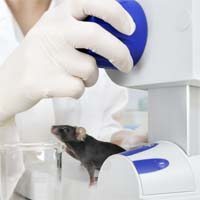New Mouse Model for Mesothelioma Drug Testing
Mesothelioma is among the most challenging cancers to treat. Increasingly, doctors are taking a multi-modal approach to treatment including surgery and some combination of adjuvant therapies such as chemotherapy, radiation or other, newer modalities. But it has always been difficult to test the effectiveness of these mesothelioma therapies in the lab since they depend on the test subject having had surgery first.
Now, a group of researchers at Brigham and Women’s Hospital in Boston have come up with a more reliable way to conduct these tests. By grafting human malignant mesothelioma cells into the peritoneal cavities of laboratory mice, the researchers were able to simulate mesothelioma. The mesothelioma cells were allowed to take hold for 14 days, after which time the tumors were surgically removed via laparotomy. The result was a murine (mouse) model capable of testing various kinds of adjuvant mesothelioma therapies.
“Cytoreductive surgery in mice was feasible and reproducible, and incurred less than 5% operative mortality,” write the researchers in a summary of their experiment for the Annals of Thoracic Surgery.
After creating this murine model, the researchers used it to test a potential new therapy for mesothelioma. Before they closed the surgical wounds of the test mice, researchers treated the cavity with 10 mg of the chemotherapy drug paclitaxel loaded onto tiny, expandable nanoparticles. The nanoparticles are designed to seek out and deliver the paclitaxel into any mesothelioma cells left behind after surgery. Morbidity and survival of the mice were assessed over the next 90 days.
Although the cytoreductive surgery alone did nothing to improve survival rates, the addition of paclitaxel via the nanoparticles “significantly increased survival” compared with the untreated mice. The testers concluded that the drug “merits further evaluation for intracavitary drug delivery following the surgical resection of malignant mesothelioma.” The murine model created by the Brigham & Women’s team opens the door for more effective testing of other perioperative therapies for mesothelioma.
Sources:
Schulz, M et al, “Paclitaxel-laded Expansile Nanoparticles in a Multimodal Treatment Model of Malignant Mesothelioma”, September 30, 2011, Annals of Thoracic Surgery, Epub ahead of print.






